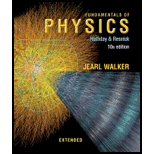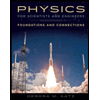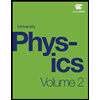
Fundamentals of Physics Extended
10th Edition
ISBN: 9781118230725
Author: David Halliday, Robert Resnick, Jearl Walker
Publisher: Wiley, John & Sons, Incorporated
expand_more
expand_more
format_list_bulleted
Textbook Question
Chapter 19, Problem 27P
Water standing in the open at 32.0°C evaporates because of the escape of some of the surface molecules. The heat of vaporization (539 cal/g) is approximately equal to en, where e is the average energy of the escaping molecules and n is the number of molecules per gram, (a) Find ε. (b) What is the ratio of ε to the average kinetic energy of H2O molecules, assuming the latter is related to temperature in the same way as it is for gases?
Expert Solution & Answer
Want to see the full answer?
Check out a sample textbook solution
Students have asked these similar questions
One mole of a dilute diatomic gas occupying a volume of 10.00 L expands against a constant pressure of 2.000 atm when it is slowly heated. If the temperature of the gas rises by 10.00 K and 400.0 J of heat are added in the process, what is its final volume?
A test is conducted to determine the overall heat transfer coefficient in a shell-and-tube oil-to-water heat exchanger that has 24 tubes of internal diameter 1.2 cm and length 2 m in a single shell. Cold water (cp = 4180 J/kg·K) enters the tubes at 20°C at a rate of 3 kg/s and leaves at 55°C. Oil (cp = 2150 J/kg·K) flows through the shell and is cooled from 120°C to 45°C. Determine the overall heat transfer coefficient Ui of this heat exchanger based on the inner surface area of the tubes.
The maximum amount of water an adult in temperate climates can perspire in one hour is typically 1.8 L. However, after several weeks in a tropical climate the body can adapt, increasing the maximum perspiration rate to 3.5 L/h. At what rate, in watts, is energy being removed when perspiring that rapidly?Assume all of the perspired water evaporates. At body temperature, the heat of vaporization of water is Lv = 24 × 105 J/kg.
Chapter 19 Solutions
Fundamentals of Physics Extended
Ch. 19 - For four situations for an ideal gas, the table...Ch. 19 - In the p-V diagram of Fig. 19-17, the gas does 5 J...Ch. 19 - For a temperature increase of T1, a certain amount...Ch. 19 - The dot in Fig, 19-18a represents the initial...Ch. 19 - A certain amount of energy is to be transferred as...Ch. 19 - The dot in Fig. 19-18b represents the initial...Ch. 19 - a Rank the four paths of Fig. 19-16 according to...Ch. 19 - The dot in Fig. 19-18c represents the initial...Ch. 19 - Prob. 9QCh. 19 - Does the temperature of an ideal gas increase,...
Ch. 19 - Prob. 1PCh. 19 - Gold has a molar mass of 197 g/mol. a How many...Ch. 19 - SSM Oxygen gas having a volume of 1000 cm3 at...Ch. 19 - A quantity of ideal gas at: 10.0C and 100 kPa...Ch. 19 - The best laboratory vacuum has a pressure of about...Ch. 19 - Water bottle in a hot car. In the American...Ch. 19 - Suppose 1.80 mol of an ideal gas is taken from a...Ch. 19 - Compute a the number of moles and b the number of...Ch. 19 - An automobile tire has a volume of 1.64 102 m3...Ch. 19 - A container encloses 2 mol of an ideal gas that...Ch. 19 - SSM ILW WWW Air that initially occupies 0.140 m3...Ch. 19 - GO Submarine rescue. When the U.S. submarine...Ch. 19 - Prob. 13PCh. 19 - In the temperature range 310 K to 330 K, the...Ch. 19 - Suppose 0.825 mol of an ideal gas undergoes an...Ch. 19 - An air bubble of volume 20 cm3 is at the bottom of...Ch. 19 - GO Container A in Fig. 19-22 holds an ideal gas at...Ch. 19 - The temperature and pressure in the Suns...Ch. 19 - a Compute the rms speed of a nitrogen molecule at...Ch. 19 - Calculate the rms speed of helium atoms at 1000 K....Ch. 19 - SSM The lowest possible temperature in outer space...Ch. 19 - Find the rms speed of argon atoms at 313 K. See...Ch. 19 - A beam of hydrogen molecules H2 is directed toward...Ch. 19 - At 273 K and 1.00 102 atm, the density of a gas...Ch. 19 - Prob. 25PCh. 19 - Prob. 26PCh. 19 - Water standing in the open at 32.0C evaporates...Ch. 19 - At what frequency would the wavelength of sound in...Ch. 19 - SSM The atmospheric density at an altitude of 2500...Ch. 19 - Prob. 30PCh. 19 - In a certain particle accelerator, protons travel...Ch. 19 - Prob. 32PCh. 19 - Prob. 33PCh. 19 - Prob. 34PCh. 19 - Prob. 35PCh. 19 - The most probable speed of the molecules in a gas...Ch. 19 - Prob. 37PCh. 19 - Figure 19-24 gives the probability distribution...Ch. 19 - At what temperature does the rms speed of a...Ch. 19 - Two containers are at the same temperature. The...Ch. 19 - Prob. 41PCh. 19 - What is the internal energy of 1.0 mol of an ideal...Ch. 19 - Prob. 43PCh. 19 - GO One mole of ail ideal diatomic gas goes from a...Ch. 19 - ILW The mass of a gas molecule can be computed...Ch. 19 - Under constant pressure, the temperature of 2.00...Ch. 19 - The temperature of 2.00 mol of an ideal monatomic...Ch. 19 - GO When 20.9 J was added as heat to a particular...Ch. 19 - SSM A container holds a mixture of three...Ch. 19 - We give 70 J as heat to a diatomic gas, which then...Ch. 19 - Prob. 51PCh. 19 - GO Suppose 12.0 g of oxygen O2 gas is heated at...Ch. 19 - SSM WWW Suppose 4.00 mol of an ideal diatomic gas...Ch. 19 - We know that for an adiabatic process pV = a...Ch. 19 - A certain gas occupies a volume of 4.3 L at a...Ch. 19 - Suppose 1.00 L of a gas with = 1.30, initially at...Ch. 19 - The volume of an ideal gas is adiabatically...Ch. 19 - GO Opening champagne. In a bottle of champagne,...Ch. 19 - GO Figure 19-26 shows two paths that may be taken...Ch. 19 - GO Adiabatic wind. The normal airflow over the...Ch. 19 - GO A gas is to be expanded from initial state i to...Ch. 19 - GO An ideal diatomic gas, with rotation but no...Ch. 19 - Figure 19-27 shows a cycle undergone by 1.00 mol...Ch. 19 - Calculate the work done by an external agent...Ch. 19 - An ideal gas undergoes an adiabatic compression...Ch. 19 - Prob. 66PCh. 19 - An ideal monatomic gas initially has a temperature...Ch. 19 - Prob. 68PCh. 19 - SSM The envelope and basket of a hot-air balloon...Ch. 19 - An ideal gas, at initial temperature T1 and...Ch. 19 - Prob. 71PCh. 19 - At what temperature do atoms of helium gas have...Ch. 19 - Prob. 73PCh. 19 - Prob. 74PCh. 19 - The temperature of 3.00 mol of a gas with CV =...Ch. 19 - During a compression at a constant pressure of 250...Ch. 19 - SSM Figure 19-28 shows a hypothetical speed...Ch. 19 - Prob. 78PCh. 19 - SSM An ideal gas undergoes isothermal compression...Ch. 19 - Oxygen O2 gas at 273 K and 1.0 atm is confined to...Ch. 19 - An ideal pas is taken through a complete cycle in...Ch. 19 - Prob. 82PCh. 19 - SSM A sample of ideal gas expands from an initial...Ch. 19 - An ideal gas with 3.00 mol is initially in state 1...Ch. 19 - A steel lank contains 300 g of ammonia gas NH3 at...Ch. 19 - In an industrial process the volume of 25.0 mol of...Ch. 19 - Figure 19-29 shows a cycle consisting of five...Ch. 19 - An ideal gas initially at 300 K is compressed at a...Ch. 19 - A pipe of length L = 25.0 m that is open at one...Ch. 19 - In a motorcycle engine, a piston is forced down...Ch. 19 - For adiabatic processes in an ideal gas, show that...Ch. 19 - Air at 0.000C and 1.00 atm pressure has a density...Ch. 19 - Prob. 93PCh. 19 - Prob. 94PCh. 19 - Prob. 95PCh. 19 - For air near 0C, by how much does the speed of...Ch. 19 - Prob. 97P
Additional Science Textbook Solutions
Find more solutions based on key concepts
Whats the potential difference between the terminals of a battery that can impart 7.21019 J to each electron th...
Essential University Physics: Volume 2 (3rd Edition)
The metal outside the curve.
Physics: Principles with Applications
69. An ultrasound unit is being used to measure a patient’s heartbeat by combining the emitted 2.0 MHz signal w...
College Physics: A Strategic Approach (4th Edition)
In a separate experiment, two hands push horizontally on the block. Hand 1 does positive work and hand 2 does n...
Tutorials in Introductory Physics
The graph below plots the luminosity of a star on the vertical axis against the star's surface temperature on t...
Lecture- Tutorials for Introductory Astronomy
A mass m, undergoes circular motion of radius R on a horizontal frictionless table, connected by a massless str...
Essential University Physics: Volume 1 (3rd Edition)
Knowledge Booster
Learn more about
Need a deep-dive on the concept behind this application? Look no further. Learn more about this topic, physics and related others by exploring similar questions and additional content below.Similar questions
- One of a dilute diatomic gas occupying a volume of 10.00 L expands against a constant pressure of 2.000 atm when it is slowly heated. If the temperature of the gas rises by 10.00 K and 400.0 J of heat are added in the process, what is its final volume?arrow_forwardAn aluminum rod 0.500 m in length and with a cross-sectional area of 2.50 cm2 is inserted into a thermally insulated vessel containing liquid helium at 4.20 K. The rod is initially at 300 K. (a) If one-half of the rod is inserted into the helium, how many liters of helium boil off by the time the inserted half cools to 4.20 K? Assume the upper half does not yet cool. (b) If the circular surface of the upper end of the rod is maintained at 300 K, what is the approximate boil-off rate of liquid helium in liters per second after the lower half has reached 4.20 K? (Aluminum has thermal conductivity of 3 100 W/m K at 4.20 K; ignore its temperature variation. The density of liquid helium is 125 kg/m3.)arrow_forwardFor a temperature increase of 10 at constant volume, what is the heat absorbed by (a) 3.0 mol of a dilute monatomic gas; (b) 0.50 mol of a dilute diatomic gas; and (c) 15 mol of a dilute polyatomic gas?arrow_forward
- One process for decaffeinating coffee uses carbon dioxide ( M=44.0 g/mol) at a molar density of about 14,0 mol/m3 and a temperature of about 60 . (a) Is CO2 a solid, liquid, gas, or supercritical fluid under those conditions? (b) The van der Waals constants for carbon dioxide are a=0.3658 Pa m6/mol2 and b=4.286105 m3/mol. Using the van der Waals equation, estimate pressure of CO2 at that temperature and density. `arrow_forwardA weather balloon is designed to expand to a maximum radius of 22 m at its working altitude, where the air pressure is 0.030 atm and the temperature is 200 K. If the balloon is filled at atmospheric pressure and 309 K, what is its radius at liftoff?arrow_forwardAssume Lake Superior contains 1.20 ✕ 1013 m3 of water, and assume the water's density is that of water at 20°C and 1 atm. (a) How much energy (in J) is required to raise the temperature of that volume of water from 14.0°C to 21.2°C? J (b) How many years would it take to supply this amount of energy by using a power of 1,400 MW generated by an electric power plant? yrarrow_forward
- The molar heat capacity of Naphthalene is given by C_p(T)=T^3e^-T at constant pressure. How much heat must be absorbed to warm 3.7 moles from T1 to T2?arrow_forwardMost automobiles have a coolant reservoir to catch radiator fluid that may overflow when the engine is hot. Such a radiator, made of copper, is filled to its 11-L capacity when at 10.0°C. a. What volume of radiator fluid, in liters, will overflow when the radiator and fluid reach their 98°C operating temperature, given that the fluid’s thermal coefficient of volume expansion is 400.0 × 10-6 / °C? The coefficient of volume expansion for copper is 5.1 × 10-5 /°C.arrow_forwardDuring a long sleepless night, you wonder about the thermodynamic properties of the air in your room. If your room has a volume of 20 m3, the pressure is 9.8x 104 Pa and the temperature is 20°C, what is the total translational kinetic energy of the air molecules in your room?arrow_forward
- Water enters a 2.5-cm-internal-diameter thin copper tube of a heat exchanger at 15°C at a rate of 0.3 kg/s, and is heated by steam condensing outside at 120°C. If the average heat transfer coefficient is 800 W/m2·°C, determine the length of the tube required in order to heat the water to 115°Carrow_forwardONLY ANSWER 6 3. A diesel engine powers a boat. The engine’s cylinders each have a cut-offratio (V3/V2) of 2 and the V3 is 4ft3. If 1 cylinder is in the isobaric expansionstroke, find the final temperature if the initial temperature is 540F. 6. From number 3, if the gas tank accident happened on top of Mt. Everest’s summit where patm is only 33.7 kpa and the readings obtained are the same, find the new final temperature.arrow_forwardAn ideal gas initially at 300 K undergoes an isobaric expansion at 2.50 kPa. If the volume increases from 1.00 m3 to 3.00 m3 and 12.5 kJ is transferred to the gas by heat, what are the change in its internal energy (in kJ)?arrow_forward
arrow_back_ios
arrow_forward_ios
Recommended textbooks for you
 Physics for Scientists and Engineers: Foundations...PhysicsISBN:9781133939146Author:Katz, Debora M.Publisher:Cengage Learning
Physics for Scientists and Engineers: Foundations...PhysicsISBN:9781133939146Author:Katz, Debora M.Publisher:Cengage Learning Principles of Physics: A Calculus-Based TextPhysicsISBN:9781133104261Author:Raymond A. Serway, John W. JewettPublisher:Cengage Learning
Principles of Physics: A Calculus-Based TextPhysicsISBN:9781133104261Author:Raymond A. Serway, John W. JewettPublisher:Cengage Learning

Physics for Scientists and Engineers: Foundations...
Physics
ISBN:9781133939146
Author:Katz, Debora M.
Publisher:Cengage Learning

Principles of Physics: A Calculus-Based Text
Physics
ISBN:9781133104261
Author:Raymond A. Serway, John W. Jewett
Publisher:Cengage Learning

Thermodynamics: Crash Course Physics #23; Author: Crash Course;https://www.youtube.com/watch?v=4i1MUWJoI0U;License: Standard YouTube License, CC-BY